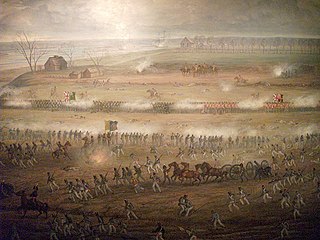
The Battle of Crysler's Farm, also known as the Battle of Crysler's Field, was fought on 11 November 1813, during the War of 1812. A British and Canadian force won a victory over a US force which greatly outnumbered them. The US defeat prompted them to abandon the St. Lawrence Campaign, their major strategic effort in the autumn of 1813.
Dundas County is a former county in the province of Ontario, Canada. It was named after Henry Dundas, 1st Viscount Melville, who was the British Home Secretary (1791–1794), with responsibility for the colonies.

The Battle of Ogdensburg was a battle of the War of 1812. The British gained a victory over the Americans and captured the village of Ogdensburg, New York. Although small in scale, it removed the American threat to British supply lines for the remainder of the war.

Stormont, Dundas and Glengarry Highlanders is a Primary Reserve infantry regiment of the Canadian Army. It is part of 33 Canadian Brigade Group, 4th Canadian Division and is headquartered in Cornwall, Ontario.
Thomas Fraser was a soldier and political figure in Upper Canada.
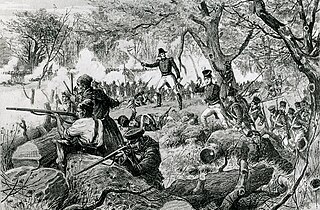
When the United States and the United Kingdom went to war against each other in 1812, the major land theatres of war were Upper Canada, Michigan Territory, Lower Canada and the Maritime Provinces of Nova Scotia, New Brunswick, Prince Edward Island and Cape Breton . Each of the separate British administrations formed regular and fencible units, and both full-time and part-time militia units, many of which played a major part in the fighting over the two and a half years of the war.

Peter Shaver was a farmer, businessman and political figure in Upper Canada.

Richard Duncan Fraser was a fur trader, businessman, farmer and political figure in Upper Canada.

Fort Wellington National Historic Site is a historic military fortification located on the north shore of the St. Lawrence River at Prescott, Ontario. The military fortification was used by the British Army, and the Canadian militia for most of the 19th century, and by the militia in the 20th century, until 1923, when the property was handed over to the Dominion Parks Commission, the predecessor to Parks Canada. The fort was earlier named a National Historic Site of Canada in January 1920.
The Battle of Cowan's Ford was a battle in the Southern Theater of Cornwallis's 1780–1782 Campaign that eventually led to the British Army's surrender at Yorktown during the American Revolutionary War. It was fought on February 1, 1781, at Cowan's ford on the Catawba River in northwestern Mecklenburg County, North Carolina, between a force of about 2,400 British and about 800 Whig militia who were attempting to slow the British advance across the river. The American general William Lee Davidson was killed in this battle.
The Glengarry Light Infantry Fencibles were a light infantry unit, raised chiefly in the Glengarry District of Upper Canada shortly before the outbreak of the Anglo-American War of 1812. The unit fought throughout the war, and was disbanded shortly afterwards.

The Grenville Regiment (Lisgar Rifles) was an infantry regiment of the Non-Permanent Active Militia of the Canadian Militia (now the Canadian Army) based in Grenville County, Ontario.
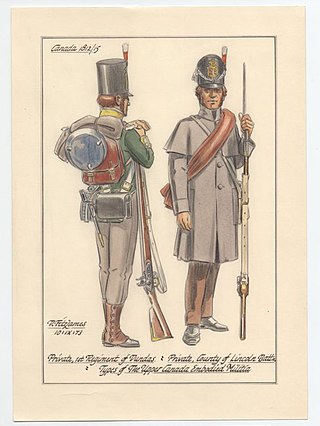
The Dundas County Militia was a regiment of the provincial militia of Upper Canada that was raised in Dundas County, Ontario, in the 1780s. The battle honours and legacy of the Dundas Militia are perpetuated by the Stormont, Dundas and Glengarry Highlanders.
The Battle of French Mills or First Salmon River Raid was a raid and battle fought on November 22, 1812. 100 American soldiers stationed at French Mills led a successful attack against 45 Canadian voyageurs on 22 October at the Battle of St. Regis. Half returned to French Mills while the other half departed for Plattsburgh, New York. In retribution, a mix of Canadian regulars and militia amounting to 150 men attacked the 50 Americans at French Mills forcing their surrender.
The Middlesex Militia was a regiment of the provincial militia of Upper Canada that was raised in Middlesex County, Ontario, in the early 1800s. The Middlesex Militia is currently perpetuated by the 4th Battalion, Royal Canadian Regiment.
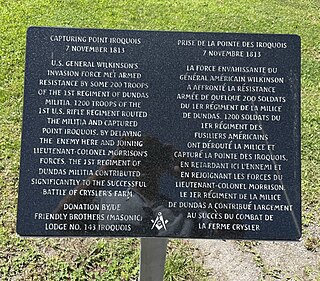
The Battle of Point Iroquois was a small skirmish fought on the morning of November 8, 1813, as part of Wilkinson's advance up the St. Lawrence towards Montreal. The skirmish occurred on the shores of the St. Lawrence River at Point Iroquois, Dundas County, where the river reached its narrowest point, only 500 yards across.
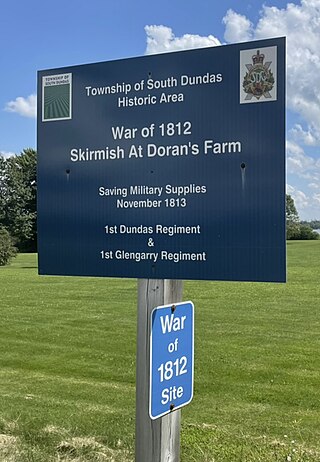
The Skirmish at Doran's Farm was a small skirmish during the War of 1812 fought during Wilkinson's advance up the St. Lawrence.
The Raid on Madrid was a small raid by Canadian Militia and Royal Marines on the village of Madrid, New York, during the War of 1812.
The Assault on Ogdensburg, also known as the First Battle of Ogdensburg or the Battle of Prescott, was an attack by Canadian militia on the American defences at Ogdensburg on October 4, 1812.











